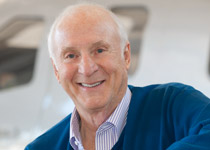Noted aviation writer Barry Schiff flew for TWA for 34 years.
Above the wet, lumpy cumulus, we sail on silken air beneath a canopy dotted with distant diamonds. We are strangers flying over foreign lands, but my celestial compatriots provide comforting familiarity. Polaris winks from starboard and the Southern Cross stalks from port.
The flight to Tel Aviv will take seven hours, two hours longer than would be necessary if the Middle East nations could coexist peacefully; we must fly 900 nautical miles out of the way to avoid neighbors unfriendly to the Jewish state. In this region, flight planning is determined as much by political climate as by winds and weather.
We turn northward and fly an aerial tightrope over the narrow Red Sea. Passing between Egypt and Saudi Arabia, we stare upon a world seemingly uninhabited. It is difficult to appreciate global overpopulation from our vantage point; most of the Earth seems untouched. Our topographical chart contains a number of "Unsurveyed" notations.
Approaching Israel from over the Mediterranean, we aim for the Shalom Tower, once the tallest building in the Middle East, and pass over Tel Aviv, a sprawling coastal city that from aloft resembles Miami. Over the nose, we see the Dead Sea.
The landing at Tel Aviv is routine, but to some Jewish passengers it is like seeing their newborn child for the first time. The touchdown on Israeli soil triggers cheers and applause that echo throughout the cabin, a spontaneous flood of emotion from people who have struggled for years if not centuries for the fulfillment of this moment. An elderly couple bolts from the aircraft and they weep uninhibitedly as they fall to their knees to kiss the tarmac.
Airline pilots contend that the most dangerous part of a flight is the drive to and from the airport. Nowhere in the world is this truer than here. Israelis drive as if they were in Sherman tanks on the road to Riyadh.
The next day our engines etch four contrails above the jagged coast of Greece lying fragmented at the base of the Balkan Peninsula like the ruins of an Athenian temple.
It is difficult for us to stay ahead of the game when flying across Europe. The rules change every time we cross a border, which is often. Just when we become accustomed to the heavily accented English of one nationality, we switch to another. (The French controllers seem most difficult to understand.)
A flight across Europe is more than regulations. It is sailing above a fairyland of castles, cultures, and contrasts. A glance in any direction finds a scene lifted from the pages of history.
London's Heathrow Airport is the busiest and often the foggiest in Europe. Fog here can be so thick that a taxiing pilot could get lost for hours. As a result, the British developed a ground guidance system. Working like the track switcher at a railroad yard, the ground controller leads a pilot to his gate by turning on only the appropriate taxiway lights.
We are embarking on the final leg of our globe-girdling journey. The fuel tanks burgeon with fuel, and the wings sag under the load. Los Angeles is at the far end of a 5,217-nm great-circle route across the roof of the world, an aerial Northwest Passage. The thrust levers are advanced, and the aircraft accelerates slowly, with little apparent will to fly.
In the cabin, a veteran flight attendant sits in her jump seat facing the passengers. She is accustomed to the necessarily long takeoff roll. Sensing passenger concern, she announces on the public-address system: "Ladies and gentlemen, you can help by lifting your feet." Obediently, hundreds of feet rise, and we push up at 170 knots.
Over Scotland, we head northwest and leave behind the spider web of airways and incessant chatter. Ahead is the peaceful serenity of watching brilliant white ice floes drifting in frigid black water. In the Arctic, visibility is so good that it hurts your eyes to see that far.
After crossing the Denmark Strait, we interrupt the cabin movie to point out the spectacle passing below: Greenland, the world's largest island with the most inappropriate name. Jagged peaks cast ragged shadows against the two-mile-thick icecap. Glacial fingers of ice probe for the sea, grinding mountains that stand in their way, the same awesome, slow-motion process that carved the continents.
From above, the Arctic has a fearsome yet inviting beauty. There is an incongruity about it that makes it pleasant to fly here. Polar regions are vast deserts, characterized by light wind, low humidity, infrequent and thin cloudiness, and little rain or snow. Winds aloft seldom exceed 30 knots. By contrast, a flight across America presents greater problems: fronts, thunderstorms, tornados, all forms of precipitation, and strong winds.
We cross the Davis Strait, aiming for Frobisher on Baffin Island in northeast Canada. Approaching the north magnetic pole, the wet compass becomes unreliable and soon fluctuates wildly or points east when it should point west. Our polar-path compasses fortunately provide reference to true north. Our track angles southwest, and Mount Rainier eventually pokes its lofty head above the clouds, welcoming us home.
We now have 19 days to recover from this and prepare for our next 11-day global odyssey, but our Boeing 707 is given no such relief. Within a few hours and with a fresh crew, it will begin another 20,368-nm flight around the world.
Visit the author's Web site ( www.barryschiff.com).



